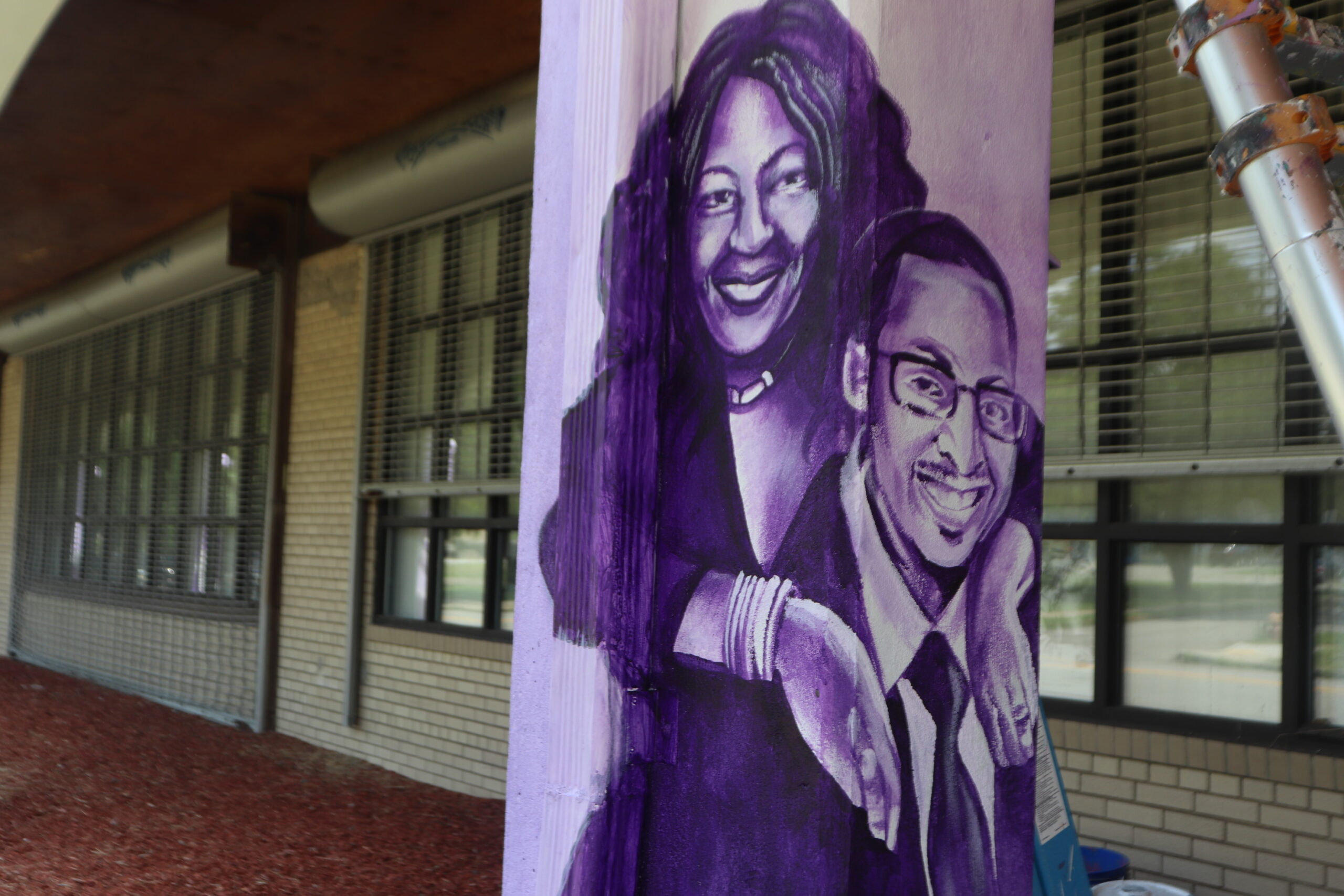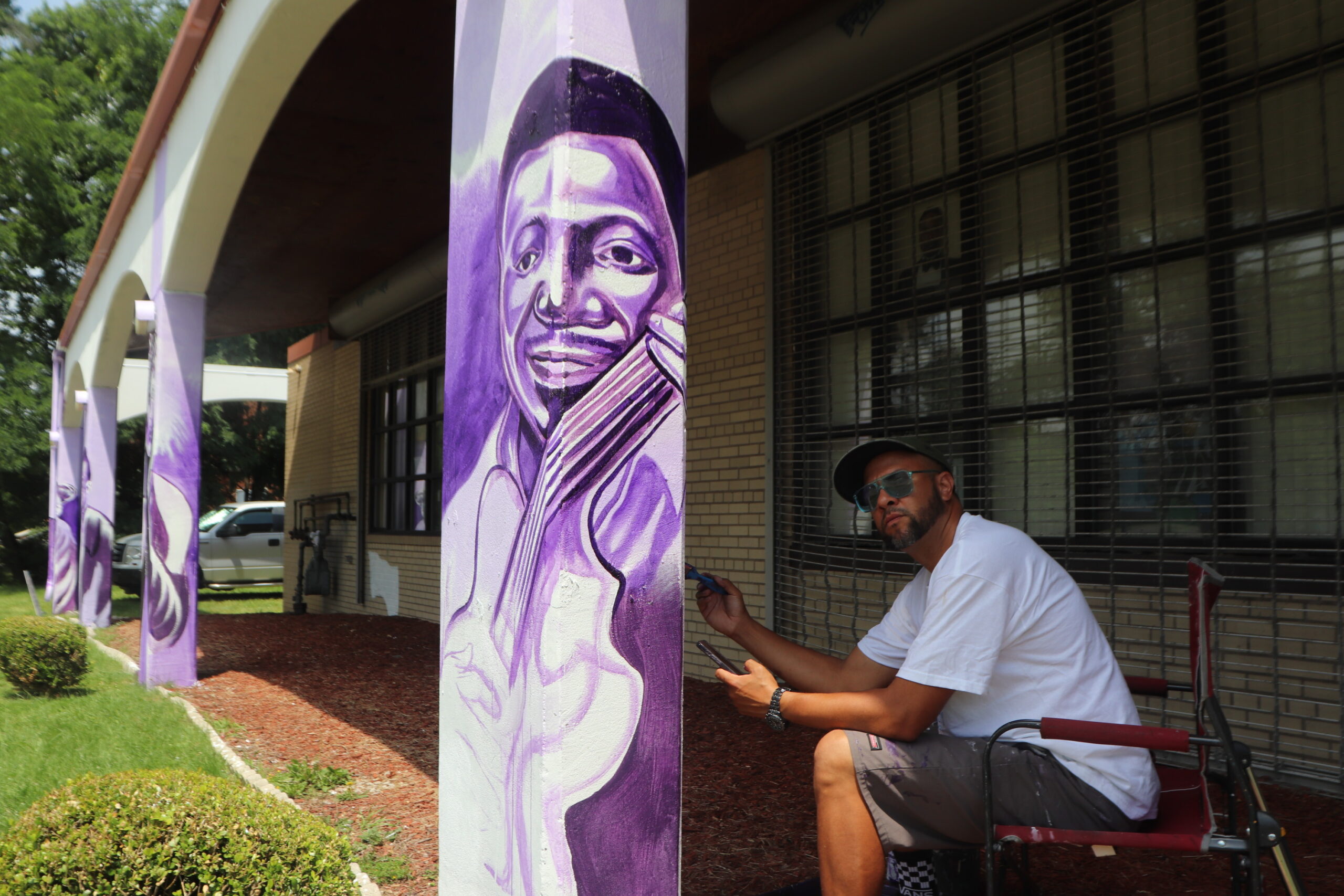AFRO-AMERICAN MUSIC INSTITUTE LEADERS DR. JAMES T. JOHNSON AND PAMELA JOHNSON, NEXT TO A MURAL OF AHMAD JAMAL.
Space will hold roughly 200 people; new ‘Mural Museum’ on display now
There is so much history inside the walls of the Afro-American Music Institute, in Homewood.
Take a tour inside, and you’ll see the irreplaceable photos of some of jazz’s all-time greats, along with today’s jazz aficionados who are keeping the famed music genre vivacious. You’ll notice the different instruments, countless videos and audiotapes, and the rooms where Dr. James T. Johnson teaches some 200 to 300 students yearly the ins and outs of music through a specialized curriculum in gospel, jazz, and other forms of the African Diaspora.
But the energetic Dr. Johnson told the New Pittsburgh Courier in an exclusive interview, July 6, that oftentimes, when one of his students performs at their recital, “one student…would bring the parents, grandparents, uncles, aunts, sister and the brothers, and the first cousin,” he said. “It got to the point that I would have to ask some young people to get up to let the older people sit down.”
 https://newpittsburghcourier.com/wp-content/uploads/sites/3/2023/09... 600w, https://newpittsburghcourier.com/wp-content/uploads/sites/3/2023/09...
https://newpittsburghcourier.com/wp-content/uploads/sites/3/2023/09... 600w, https://newpittsburghcourier.com/wp-content/uploads/sites/3/2023/09...
ARTIST KYLE HOLBROOK, FAR RIGHT, WITH LEADERS OF THE AFRO-AMERICAN MUSIC INSTITUTE IN HOMEWOOD.
Dr. Johnson’s talking about the loading dock in the rear of the AAMI building that’s used as a multi-purpose room. It holds about 75 people, and that’s where a lot of the organization’s events and performances are held, namely the popular “Jazz on the Loading Dock” series.
Dr. Johnson’s wife, Pamela, said enough was enough. “We need to have our own space,” she told the Courier, which led her to announce that the Afro-American Music Institute would be expanding its physical space.
Pamela Johnson said the addition to the building at 7131 Hamilton Ave. will be in the rear, and it will be able to hold up to 200 people, almost triple the amount of the current loading dock space. Reverend Deryck Tynes, chairman of the board for the Afro-American Music Institute, said $500,000 in funding has already been raised, and an aggressive plan is in the works to raise the $2 million more needed to complete the building addition.
 https://newpittsburghcourier.com/wp-content/uploads/sites/3/2023/09... 600w, https://newpittsburghcourier.com/wp-content/uploads/sites/3/2023/09...
https://newpittsburghcourier.com/wp-content/uploads/sites/3/2023/09... 600w, https://newpittsburghcourier.com/wp-content/uploads/sites/3/2023/09...
A MURAL OF AAMI FOUNDERS THE JOHNSONS. SEE ALL THE FINISHED VERSIONS NOW AT THE AAMI BUILDING.
Pamela Johnson and Rev. Tynes said the space would be called the “Ahmad Jamal Performance Hall,” or a similar title that, no matter what, would honor Jamal, one of the most accomplished jazz musicians of all-time. Jamal, born in 1930 and who died in April of this year, was a Pittsburgher who graduated from Westinghouse High School in 1948. Among Jamal’s numerous awards was the Grammy Lifetime Achievement Award, in 2017.
Reverend Tynes said the new space, scheduled to open by the fall of 2026, could be available to the community for outside events.
Dr. Johnson, known as “Dr. J.,” told the Courier the new space should have “some type of quality performance (every quarter) from a musical group from the Diaspora since our mission covers the Diaspora. When people come to know that it’s going to be something there of quality every quarter; ‘we don’t know what it’s going to be but it’s going to be good, so let’s show up,’ that’s what I want to get to.”
Reverend Tynes said AAMI is in talks with the corporate and philanthropy community about their contributions to the new performance space. He also said individuals can contribute to the capital campaign by going to AAMI’s website, afroamericanmusic.org.
What can be experienced right now at the AAMI building is a new “Mural Museum,” curated by artist Kyle Holbrook. Holbrook, known for his murals all throughout the Pittsburgh region, the nation and the world, said he’s had a “longtime relationship with Dr. J and Pam,” and knows how much they mean to the Pittsburgh community, the Homewood community, and the music community internationally.
Visit the Afro-American Music Institute, and you’ll see the paintings outside of the music greats—Ahmad Jamal, Mary Cardwell Dawson, Billy Strayhorn, Maxine Sullivan, George Benson, Kenny Clarke, Phyllis Hyman, Erroll Garner, Mary Lou Williams, Dakota Staton and Art Blakey. It took pretty much the entire summer for Holbrook to perfect the murals, but that’s not all. He said each mural will have “QR codes” under them, which allows a person to scan the code with a smartphone. The phone will then show information on that particular musician.
“They (the Johnsons) wanted to do something that was going to be here that would be educational,” Holbrook told the Courier, “so people can know who they are because these are legends.”
 https://newpittsburghcourier.com/wp-content/uploads/sites/3/2023/09... 600w
https://newpittsburghcourier.com/wp-content/uploads/sites/3/2023/09... 600w
Holbrook painted a mural on an outside wall of the AAMI building back in 2005, but these murals are on the columns on the front and sides of the building. They’re painted in purple, green and gold colors.
Dr. Johnson, who started the Afro-American Music Institute in 1982, told the Courier you can’t say “jazz” without “Pittsburgh.” He said when you combine the talent that came from Pittsburgh with the impact they’ve had on the jazz circuit, it’s unmatched.
“Pittsburgh is a city of innovators,” Dr. Johnson told the Courier. “Everybody else…is a city of imitators.”
You need to be a member of Pittsburgh Jazz Network to add comments!
Join Pittsburgh Jazz Network